This is the first of my Teaching Language Online With… series, in which I share a tech tool that I use either in my online Hebrew classes, or to prepare materials for my students and courses. The posts will have two main parts; part 1 will give a short overview of the tool, and in part 2, I’ll share some of the ways in which I’ve used the tool to teach language online.
Today’s featured tech tool for teaching language online is Classkick.
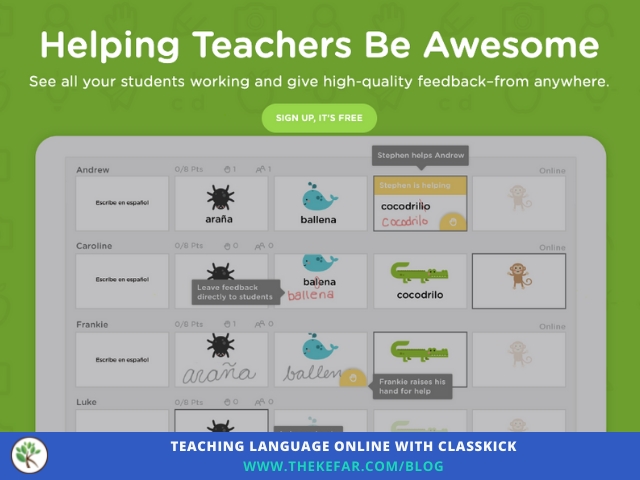
What is Classkick and what can you do with it? Classkick is a whiteboard platform that lets teachers create a variety of activities that can be done in class, or assigned for homework. One of the great things about teaching language online with Classkick is that it lets you see your students’ screens in real time, making it super useful for assessments, whole class activities, and games like Bingo. You can create multiple choice and fill-in-the-blank exercises that will be graded automatically, record audio directly in the platform, insert links, upload images or PDFs (which you can easily turn into digital worksheets), and more.
Does Classkick have a free version? Classkick does have a very robust free version, with nearly all of the Pro functionalities available on the free plan. One of the limitations of the free plan is the number of assignments that you’re able to create; in Classkick, an assignment is like a notebook with blank whiteboard pages. The free version gives you 20 ‘notebooks,’ but you can have at least 100 whiteboard pages in each. The Pro version for individual teachers is $12.99 or $17.99, depending on whether you opt to be billed monthly or annually. School and district pricing options are also available, and you can see the pricing schedule and free vs Pro comparisons here.
Do students need to create Classkick accounts? Students do not need to create Classkick accounts. You can send them direct links to assignments, or share a class code for them to input on the Classkick student log in page (no email or password required). You do, however, have the option to create student accounts with emails and passwords, and if you have the Pro plan, you can integrate with Google Classroom and create student portfolios.
How I Use Classkick to Teach Language Online
One of the ways in which I like to use Classkick in my online language classes is to annotate readings. I upload a text as a PDF document using the camera tool, and students can use the highlighter and/or pen tools to annotate the text. They can highlight unfamiliar words, underline a sentence they have a question about, leave comments using the text box, etc. Martina Bex over at the Comprehensible Classroom has great annotation keys in English, Spanish, and French.
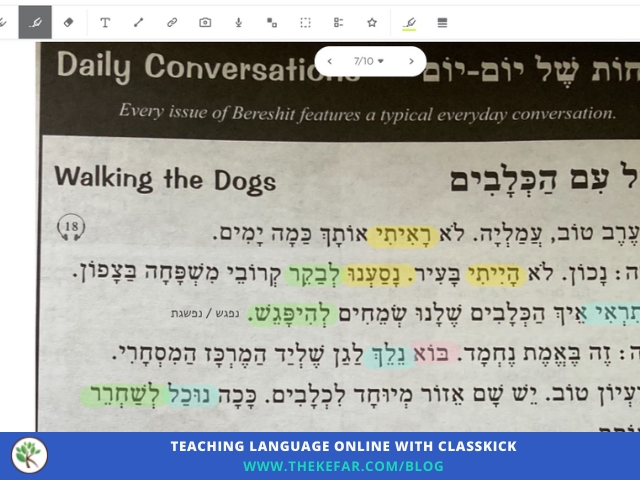
In a 1-on-1 session with a student, we read this Hebrew text together, pausing regularly to discuss. We read it again in Classkick and I highlighted words they didn’t remember, and put those words in a Wordwall for the student to practice. Then, we focused on the verbs (shown above), and highlighted them in different colors based on their tense, as part of a larger discussion.
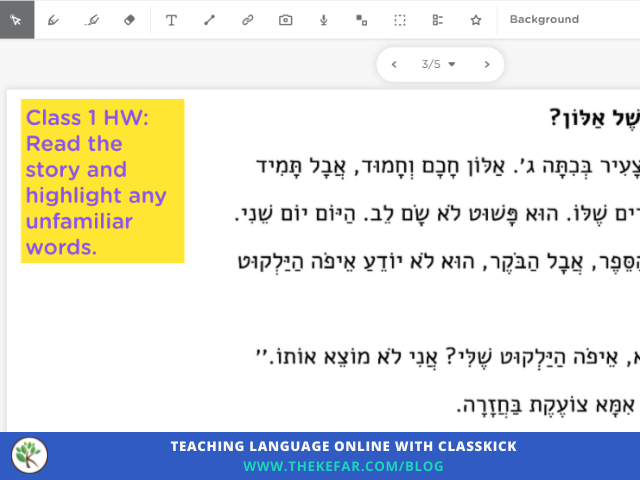
Students listened to this story in video format, and answered embedded questions via Edpuzzle. A follow up assignment was to read the same story from the video (shown above), and highlight any unfamiliar words. On the teacher dashboard, I can see every student’s annotations, which are saved automatically, and I can scroll through, and leave written, picture, or audio responses.
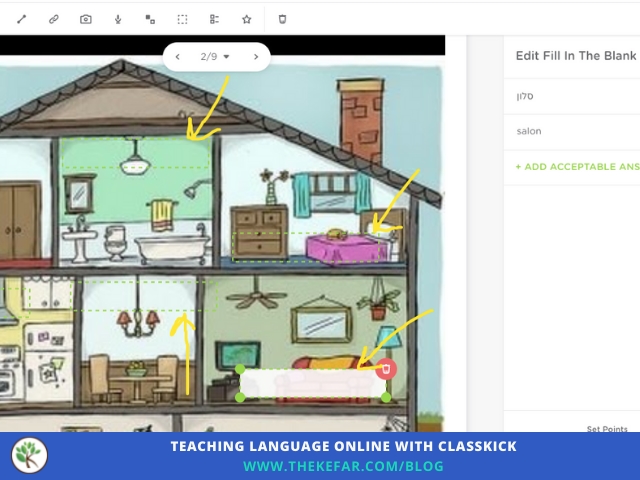
I used the fill in the blank feature so that students could label the rooms of a house. The boxes were a little hard to see against the picture background, so I used the pen tool to add arrows indicating where each box was located. You can add multiple answer choices, perfect for adding transliterations or dialect variations, and there’s also the option to assign a point value for each box.
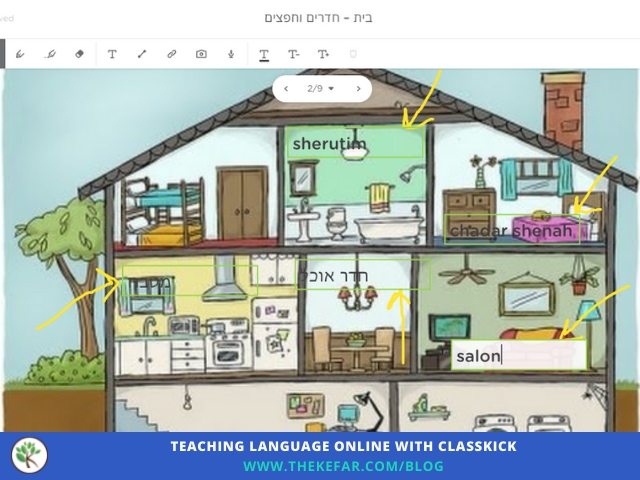
This is what the assignment looks like on the student’s end. They simply click the boxes to answer, and while they don’t see the feedback, their responses are graded automatically and shown on the teacher dashboard – one less thing for teachers to have to take care of. Easily turn any PDF worksheet into a fillable one by adding the blanks – no papers to collect and no extra work to grade.
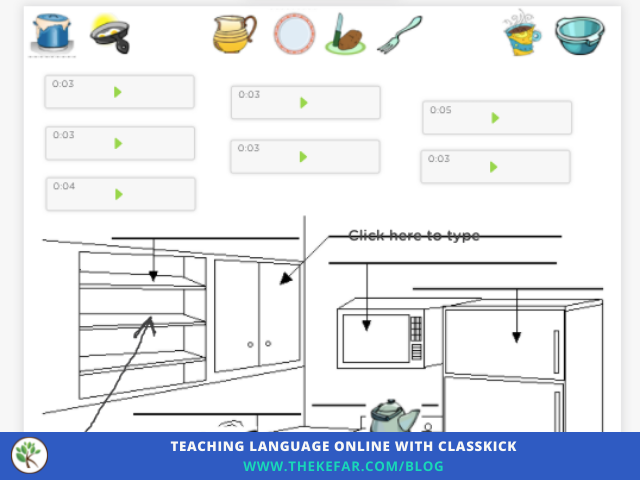
This was a listening comprehension homework assignment for an online Hebrew class. I recorded instructions in the target language (TL) such as: “put the fork on the microwave” or “put the dish in the sink.” Recording in Classkick is super easy, one click to record and another click to stop, and the recordings can be moved anywhere on the slide. The kitchen items were uploaded using the manipulatives tool, which lets students move them around as instructed. I’ve also done similar assignments live in class by giving the instructions verbally, and I can see all of my students’ work simultaneously and in real time.
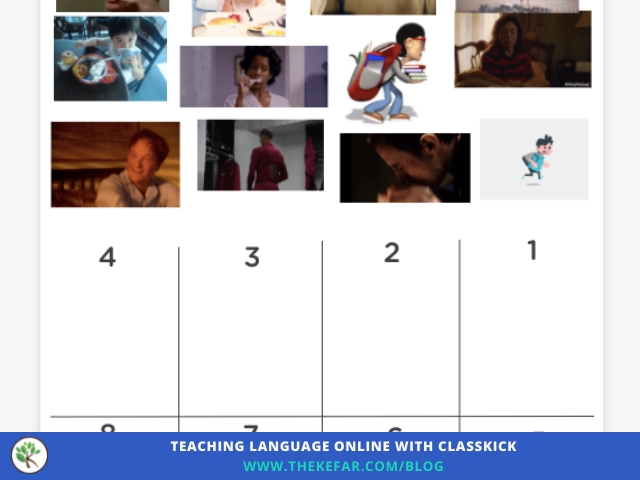
These images are actually gifs of people engaging in different morning activities, like brushing their teeth or eating breakfast. Classkick supports both static images and gifs, which makes it perfect for verb-related activities. This was an assessment I gave live in class, by naming an action (e.g. he’s brushing his teeth; she’s washing her face) in the TL, and students dragged the matching gif into the corresponding square. The numbered grid was quickly created in Classkick using the line tool, and I added the numbers using the text boxes. The gifs were uploaded as manipulatives so that students could move them.
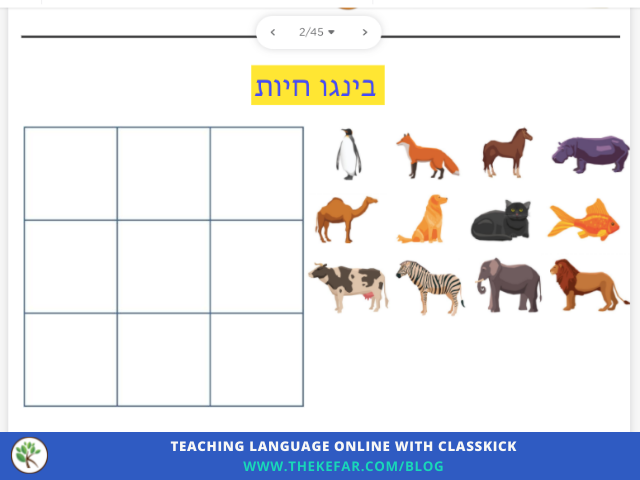
I love using Classkick to play Bingo with my online Hebrew classes because they create their own Bingo boards, and I can see everyone’s board at the same time from the teacher dashboard (each student only sees his/her board). I uploaded a grid, then added the animal pictures as manipulatives. Each student selects nine images of their choice, and arranges them on the bingo board in their desired order. I called out the animals in random order, and could watch the boards and help students as needed. I have several Classkick bingo boards, covering animals, family members, colors, numbers, foods, and more.
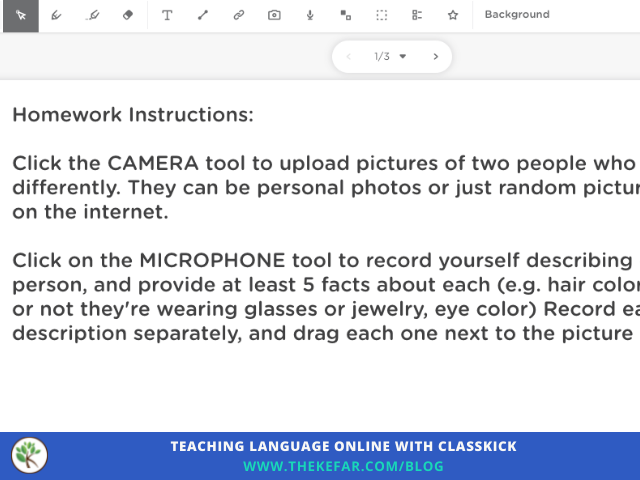
Classkick really is a blank canvas that you can do so much with. This is an example of an assignment that called for students to upload pictures and record themselves describing them in the TL. I’ve also uploaded pictures and had students record questions, or descriptions. Another idea is to record funny, wacky, or outlandish (or regular) sentences, and students have to upload or draw pictures that match the statement. Reviewing the assignment is as simple as scrolling through the whiteboard – no need to open (or keep track of!) a million emailed audio or text files.
These are just a handful of examples to show you how you can use Classkick when teaching language online; I have more, but we have to stop somewhere or we’d be here all day! For more visuals, check out the Classkick-related videos below from my YouTube channel, and you can read my post on a clothes & colors Classkick activity.
If you or your department is interested in learning about Classkick in depth, and want a step by step training on the platform, let me know! You can also visit the Teaching Language Online page to learn more about my work with teachers and schools.
Until next time, keep teaching + thriving, and I’ll see you for the next Teaching Language With… post! 💙
![]()

7 Hebrew phrases I never want to hear again: Notes from a year teaching in Israel
Have you ever thought about what you would do if a student yells out COCK in your classroom? No?...

